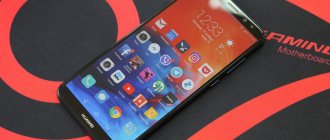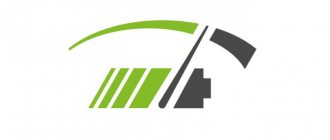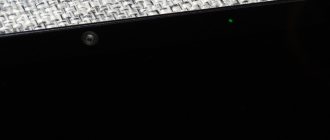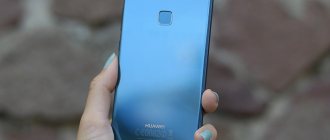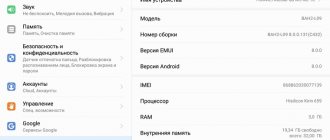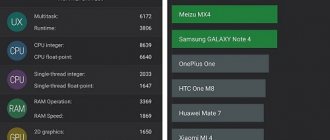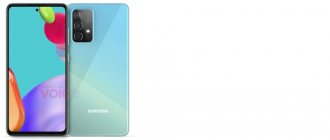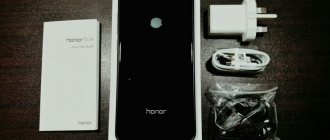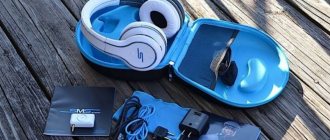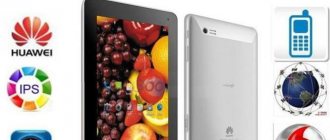Characteristics
To make a full comparison of Huawei P20 vs Huawei P20 Lite, you should first consider the characteristics of the devices. Quite often it happens that modifications differ in memory capacity or display size. In this case, the difference will not be only this. Devices differ in processors and some other parameters. Full specifications are shown in the table.
Huawei P20 smartphone
| Characteristics | Huawei P20 | Huawei P20 Lite |
| OS | Android 8.1 | Android 8.0 |
| Display | 5.8 inches, 2240*1080, IPS, Gorilla Glass 5 | 5.84 inches, 2280*1080, IPS, Gorilla Glass 5 |
| CPU | Kirin 970 | Kirin 659 |
| Memory | 4/128 GB | 4/64 GB |
| Main camera | 12+20 MP, laser focus tracking, 2x optical zoom | 16+2 MP |
| Front-camera | 24 MP | 16 MP |
| battery | 3400 mAh, fast charging | 3000 mAh |
| Interfaces | Wi-Fi, Bluetooth, Type-C, NFC, GPS, Glonass, LTE | Wi-Fi, Bluetooth, Type-C, NFC, GPS, Glonass, LTE |
| Protection | IP - 53 | |
| Size and weight | 149.1*70.8*7.65 mm, 165 grams | 148*71*7.4 mm, 145 grams |
Huawei P20 Lite smartphone
If you look at the characteristics listed above, you will notice that the Huawei P20 differs from the P20 Lite in its hardware rather than its design or dimensions . The older model, with a slightly smaller screen size, turned out to be heavier, longer and thicker. In addition, the device is protected from water and dust; the younger version did not receive it.
Huawei P20
From what is not indicated in the table, the following should be noted.
- P20 has stereo speakers, faster memory.
- The younger device benefits from the fact that memory can be added to it. The older gadget has a main memory limited to 128 gigabytes. However, this volume is enough for most tasks.
- Another difference is that the older version comes with a case and a headset, while the Lite only received a headset.
Conclusion. In terms of security, sound, and equipment, the P20 earns one point and opens the score 1:0 in favor of the older model.
Huawei P20 and P20 Pro review
There is no need to say that today Chinese smartphones are about to catch up with the Apple iPhone or Samsung Galaxy - this has long been irrelevant. Nowadays, Chinese companies and their works of art have not only caught up, but even surpassed in some ways the established global brands, although manufacturers from the Middle Kingdom have their own approach to smartphone production. Naturally, no one has canceled copying, but at the same time, unique notes in design, unique technologies that are not similar to anything available in general allow us to achieve the effect that Chinese phones are being raked in packs. Something similar was just implemented by Huawei, the third in the list of the most popular brands in the world. At the end of March, or rather on the 27th, she announced three smartphones at once: Huawei P20 Lite, P20 and P20 Pro. These gadgets, of course, are not clearly the best devices in the world, but Huawei managed to surprise the world, especially with the P20 Pro model, which received a triple camera of 40 MP + 20 MP + 8 MP!!! No one had done anything like this before, and three cameras in this case really work, although there was still some marketing involved. One way or another, today we will talk in detail about the Huawei P20 and P20 Pro models, since you can find a separate review of the Huawei P20 Lite here and the device itself is not really anything interesting.
Appearance
If you compare the Huawei P20 and P20 Light in appearance, the devices are practically no different. Both devices are not slippery, and the phones are the same in terms of the number of colors. In order not to describe the models completely, because there are a lot of reviews on the Internet, for comparison it makes sense to indicate only the differences - they are minimal.
- The older model has a fingerprint scanner located under the screen. Due to this, the diagonal is slightly smaller than that of the P20 Lite. The latter has a scanner located on the back; it is a traditionally round module.
- The next difference is that the older device has a laser focus. It is located under the camera and just above the flash. The Lite version does not have autofocus.
- The P20 has a glass back panel that resembles a mirror; the P20 Lite has a back panel made of several layers that shimmer beautifully in the sun.
- Another point that can make it clear which device is cheaper is the side edges. The edges of both devices are sloping, but the P20 has a distinctly metallic feel to it. The P20 Lite also has a metal frame, but it's made to feel like plastic.
- The younger device has a lower quality oleophobic layer. The model quickly becomes covered with fingerprints, both front and back.
The arrangement of elements, control buttons - everything is completely identical. If you look at the phones and don’t pick them up, it seems that they are almost twins. But when the devices fall into the palm of your hand, the difference becomes noticeable. This was done so that, after looking at the models, the buyer became interested in both devices, but when he took them in his hand, he felt the difference and bought a more expensive version.
Conclusion. The models do not differ in design, and no participant in the competition receives a point. But in terms of tactile sensations, the P20 is a cut above and due to this, it takes the lead with a score of 2:0.
Huawei P20 and P20 Pro - in the style of iPhone 10, but with better parameters - review
“No matter how much you feed the wolf, he keeps looking into the forest” - this is roughly how one can characterize Chinese manufacturers (especially in 2018), since they all began to copy the latest iPhone X, although before its appearance there were already many frameless models on the market. The thing is that the iPhone X lost all its frames, but got bangs - that’s what the designers from the Middle Kingdom liked. Moreover, even Google has adapted the new Android 9 OS, which will be released this year (there is only a beta for now), to the presence of bangs, which is why even third-rate manufacturers from China have begun to massively rethink the design.
One of the first companies to release analogues of the iPhone X was Asus with its ZenFone 5 and Zenfone 5z . Now the cutout at the top of the screen has been repeated by Huawei, although the new products from this company were not so successful, because the P20 and P20 Plus devices have a large frame at the bottom, in which engineers and designers at least thought of installing a Home button with a fingerprint scanner.
And although the appearance of the Huawei P20 and P20 Pro can hardly be called ideal, the manufacturer has nevertheless taken a step forward, because in comparison with the Huawei Mate 10 and Mate 10 Pro, the twenties look more modern and attractive. Moreover, comparing the Huawei P20 and P20 Pro with the same chubby Sony 2021 models, the Chinese devices turn into ideal smartphones.
Housing and battery for Huawei P20 and Z20 Plus
Usually we talk about battery and autonomy at the very end, but now the situation is a little different. I would like to talk about how the dimensions of smartphones correspond to the capacities of the installed batteries. As it turned out, the newly introduced frameless phones have become one of the best in terms of size/battery capacity. Look, with a thickness of 7.65 mm and 5.8 inches, the basic Huawei P20 device managed to accommodate as much as 3400 mAh. Just so you understand, the Smasung Galaxy S9, with a thickness of 8.5 mm and a display diagonal of 5.8 inches, has a battery of only 3000 mAh. Sony's new products, with a record thickness of 11 mm (the average thickness of a phone in 2007) and 5.7 inches, have a pitiful 3180 mAh. At the same time, Huawei P20 Plus, with a thickness of 7.8 mm and 6.1 inches, has a huge 4000 mAh battery - this is not a fairy tale, this is reality! And, of course, we need to mention the iPhone X, which, with a thickness of 7.7 mm and 5.8 inches, has a 2700 mAh battery - absolutely all owners scold it for this, since it has no autonomy.
At the same time, the installation of such large batteries led to the fact that Huawei had to give up many useful features. So the flagships have lost a slot for memory cards - 128 GB is enough for most, but given the weight of photos and videos from new cameras, a memory card would still be nice. The headphone jack has also disappeared, so either Type-C adapters or wireless headphones are used. Huawei also cut down on moisture protection, because it is there, not as advanced as in the same Galaxy S9 or S9 Plus, Sony Xperia XZ2 and others. The IP67 standard is, so to speak, basic protection that prevents moisture from penetrating inside the case only during short-term immersion and to a depth of 1 m. That is, if the device is accidentally dropped into water, then nothing will happen to it, but now experiment with it underwater, you won’t be able to record stunning videos or take interesting underwater photos - the kid will die.
As for the rest of the points regarding the body of the Huawei P20 and P20 Pro, everything is purely subjective, since someone may really like this or that element, while others will absolutely not like it. But it is worth noting the new and very interesting colors of the case. The same midnight blue or chameleon gives the devices a special charm, because you are probably already tired of these standard ones: black, gold, rose gold - you have to agree!
And when they’ve had enough of playing with the color tints on the back cover, the owners of the Huawei P20 Pro will begin to ooh and ahh, “three cameras, three!!!” Indeed, this year Chinese manufacturers, or more precisely Huawei, have surpassed themselves and all other brands, since no one today has a triple camera with a huge sensor resolution.
Triple camera in Huawei P20 Pro - why and for what?
Surely you have seen more than once stern professional photographers who carry 2, 3 or even more lenses with them, like some kind of shamans. No, this does not happen because they want it so much and they decorate themselves with “glass” like fetishists, but the whole point is that each lens is best suited only for certain types of shooting. One lens is great for portrait photography, another for landscape photography, a third for macro photography, etc.
Previously, in smartphones (although there are some now) there was only one camera eye on the back panel, which allowed you to either take good photographs, or terrible or average ones. Afterwards, the fashion for dual cameras began, which had already learned to blur the background and double the subject without losing quality (some manufacturers played with additional b/w sensors, like Huawei, or wide-angle lenses).
So we come to the answer to the question, why does the Huawei P20 Pro need three cameras at once? We answer: the first 40 MP camera in the device is necessary for ordinary photos, that is, it is a standard photo module that has always been installed in all smartphones. The second 20 MP photo module allows you to take ultra-clear photos in black and white day and night (especially at night, such is the nature of b/w sensors). In addition, the 20 MP b/w sensor helps the main 40 MP camera expand the dynamic range and clarity, because the 40 MP actually only forms the color of the picture at this time. In addition, together the cameras allow you to take portrait photos with a bokeh effect. Finally, the third 8 MP camera is a module with a telephoto lens, which can zoom objects three times closer without losing quality, that is, due to optics (compared to a 40 MP camera). At the same time, an 8 MP sensor paired with a 20 MP b/w sensor allows you to achieve a five-fold hybrid (electronic-optical) zoom with minimal loss, almost imperceptible for most users. As a result, we get a smartphone that takes standard photos equally well, copes well with portrait photography and can significantly zoom in on the frame without losing image quality, if such a need arises.
As for the Huawei P20, which has only two cameras, it’s worth talking about the changes it received in comparison with the P20 Pro. So, Huawei P20 has one 12 MP color camera (regular) and a 20 MP monochrome one. It does not have a telephoto lens as such, so the device cannot zoom in on objects without losing quality. It is worth noting that in the 20 the pixel size on the main 12 MP camera is as much as 1.55 microns with a fairly large 1/2.3″ matrix. In the P20 Pro, the pixel size is only 1 micron, but such a small size is compensated by the impressive size of the 1/1.73″ matrix itself and the clear operation of the optical-electronic image stabilizer. The Chinese have also worked hard on the lens aperture, since the Huawei P20 and P20 Pro offer an aperture of f/1.6 to 1/1.8 on different glasses.
Finally, a few words about what kind of front camera the new products have. In both cases, we have a 24 MP sensor, and since the front camera is also quite good in terms of the dimensions of the matrix, in the end we get a high-quality picture with a minimum of noise. Moreover, the company assured that the programmers have perfected the algorithmic processing, thereby achieving high quality photos, where the computer correction does not look like an eye-catching Photoshop, but a completely natural processing.
In general, smartphone cameras are crammed and stuffed “to the extreme” and this is good, because mobile photography is developing, and in modern conditions this is very important. More and more people are switching to mobile cameras because it is convenient and the quality in most cases is almost equal to that of professional equipment.
Huawei P20 and P20 Pro – display and sound
Let's start with the kosher Huawei P20 Pro - the smartphone has a gorgeous 6.1-inch OLED screen with Full HD+ resolution, and for high-quality sound it uses stereo speakers developed and calibrated together with Dolby. The device sounds very impressive, even better than the latest Galaxy S9 Plus due to richer and deeper bass.
Huawei P20 in terms of display and sound looks like a schoolboy, since it has a 5.8-inch IPS matrix and monophonic sound. Yes, both the first and second are implemented well in the smartphone: the IPS screen is of high quality, the sound is loud and bassy, but compared to the P20 Pro, all these moments simply fade. It is not known why the company made such a big difference, since both devices cost a lot of money.
Huawei P20 and P20 Pro - processor and memory
The Huawei Kirin 970 looks good today, but it’s not at all what the Snapdragon 845 chip can offer. Still, Huawei is trying to install its own chips in its products, but at the same time, its solutions are frankly inferior to the flagship solutions of its competitors. What is all this for? You could have tried to buy several dragons for top-end smartphones of the P20 and P20 Pro level, and not stick to your line. The Kirin 970 is even inferior to the Snapdragon 835 in terms of gaming power - that’s how it is, guys.
No, the Kirin 970 has enough power reserves, but we are now talking about flagships costing about $1,000. Yes, this is a huge amount, especially for a Chinese, albeit premium device. In addition, although Snapdragon 835 and 845 have the same technological process thickness, they are still different, since the first has 10 nm Low Power Early, and the second Low Power Plus. The latter is both more economical and more productive, that is, the manufacturer has perfectly refined the original technical process. In the case of the Kirin 970, this is not observed and it is exactly the same as it was a year ago. Also, despite all the neural blocks and other improvements/additions, the Kirin 970 is a non-gaming processor. You can play all games on it, but in most heavy projects, after some time of gaming there will definitely be drops in fps, because as a video accelerator from Mali, you can’t improve it, but Adreno still has to grow and grow.
And the new products are also not particularly pampered with memory, because 4 GB of RAM for a flagship in 2021 is nothing at all. The Huawei P20 Pro model already offers 6 GB of RAM and this amount is enough for most tasks, although I would like to see more. The permanent memory is only 128 GB in both cases and this is enough for 90% of users. However, the lack of memory cards still spoiled the reputation of the devices, whatever one may say.
| Huawei P20 | Huawei P20 Pro |
|
|
Display
Both models received the same IPS matrices. Due to the slightly larger display, the P20 Lite has a slightly higher resolution. Overall, both matrices are good. There is a high margin of brightness, color saturation, and viewing angles. The downside is that both models convey gray color unnaturally, and the color display calibration itself is not very accurate . Visually this is not noticeable, you can only see that the gray color is not very gray. The screen settings are the same, there is eye protection, automatic brightness adjustment, and color temperature adjustment.
Conclusion. The models are equivalent in terms of screens, but if you take into account the price of the older device, the matrix could be configured better. For this reason, one point goes into the P20 Lite treasury, and thus the score becomes 2:1. The leader is still the older device.
Screen
The Honor 20e's screen is definitely better. This is a 6.21-inch diagonal LTPS panel with a resolution of 1080x2340 pixels. The liquid crystal matrix provides fairly rich and correct color reproduction. The brightness is enough for comfortable use of the smartphone indoors, but outdoors in direct sunlight the image becomes noticeably dim. The protective film is attached from the factory. The Honor 20e is quite enjoyable to watch videos and play games on. Considering the outrageously low cost of the smartphone, the display is simply excellent.
The P40 lite E's screen is approximately 2/10" larger and features a modern front camera cutout in the left corner. And in terms of screen resolution, this smartphone is significantly inferior. It's 720x1560 pixels. The minimum pixel density is 269 per inch. That is, small text and image details no longer look as clear as on the Honor 20e, which has a pixel density exceeding 400 per inch. High resolution is the first thing you have to sacrifice in budget smartphones. Let me remind you that the P40 lite E is much cheaper than its competitor from Honor.
By the way, an interesting observation. If you have polarized glasses, look through them at the screen of your Huawei smartphone in a horizontal position.
| HONOR 20e | HUAWEI P40 lite E | |
| Diagonal | 6.21″ (15.8 cm), 90%+ area | 6.39″ (16.2 cm), 90.15% |
| Permission | 1080×2340 (FHD+), 415 ppi | 720×1560 (HD+), 269 ppi |
| Matrix | LTPS (IPS) | TFT (IPS) |
Battery
Both models have a non-removable battery, but the older model has a larger 400 mAh battery. If we translate this into hours of use, then the P20 can withstand about 1.5 days of load, the P20 Lite will last 18-20 hours. From the point of view of watching videos and games, the results are the same - 5 hours of toys, 7-8 hours of movies. The P20, with a slightly larger battery, has a serious advantage in autonomy, and this was achieved thanks to a processor that is more intelligent than its younger brother.
On a note! Huawei P20 Pro, the oldest brother in the family, can work without charging for about two days, which is very worthy for a modern flagship.
The P20 has SuperCharge charging technology, a junior QuickCharge device . The difference lies in the battery charging time. The older model will reach 65% in 30 minutes, and 100% charge in 70 minutes. The younger device will receive 50% of the battery in 30 minutes, and can get the full amount in 100 minutes. The difference is significant.
Conclusion. After assessing autonomy, the point goes to P20, and the score becomes 3:1
Design as art
As soon as you take this smartphone in your hands, you don’t want to put it back. Well, Huawei knows how to come up with a design - the gadget is thin, light, elegant and incredibly cool! The model is available in three colors: pink, blue, black. Pink is too “Samsung”, it didn’t impress me at all, but the other colors are something.
The blue is very rich and bright, but after using it for an hour and a half, you realize that the color begins to bother you. So I bet all owners will put it in a black case in a couple of months. What really caught my eye was the black – classic, what can I add here?
Although... you can add a lot! The color is just bomb, glossy and glassy - very cool, but carrying a smartphone without a case is problematic, it gets very tangled. There are fingerprints on the glass on both sides, and it is inconvenient to wipe it after each call. A neat metal frame perfectly connects the screen and the back panel - one gets the impression that the gadget is monolithic. It is very comfortable to hold in your hands and can be easily controlled with one hand.
The dual camera catches your eye, especially after you read “Great Portrait Shots” on the factory film. There is an immediate desire to see those same two cameras with your own eyes, even though this has already become commonplace.
Nothing innovative, Huawei just made a good budget one-handed flagship, that is, you can surf social networks and use the gadget without the help of a second hand, and it’s not difficult to fit it in your pocket.
The volume control and power button are located on the left.
Directly opposite is a slot for installing SIM cards.
The usual charging connector was replaced with Type-C and a headphone input was left, which is not present in the standard P20.
Tribute to Apple
Whatever one may say, the trendsetter and fashion trendsetter in the field of mobile phone production is still the Apple corporation. The released iPhone X created a revolution with its “unibrow” and gave everyone a new idea about the screen and frames. All Chinese manufacturers, with the exception of Nubia, are churning out and releasing smartphones with a “unibrow” one after another. P20 light is no exception. Despite the fact that you already know about the frameless screen, the “wow” effect when you turn it on for the first time does not go away. The screen is truly amazing!
By the way, its frames are somewhat narrower than those of the last “apple”. In older versions, the bottom frame is wider because a fingerprint scanner was built into it. In the “Lite” it is on the back, and on the bottom frame there is the inscription “HUAWEI”.
The screen is truly limitless, the sensor is very responsive, responding to a subtle touch. For those who are just getting used to Chinese smartphones, there is a cool feature - the lock is removed regardless of which way you swipe your finger: up, down, left, right. For comparison, Xiaomi cannot do this.
Impressive, isn't it? Unfortunately, if a protective glass is installed on the display, color rendering and conductivity are somewhat lost, which is very disappointing.
The menu is convenient and logical, like previous models, and is located on the desktop. There is no traditional menu, like in Samsung. This cannot be called a disadvantage, but people who are conservative and accustomed to the standard menu will get lost and confused. However, you can always find and download a widget that will create the desired illusion.
The screen quality is simply impeccable. If I were blindfolded and asked to determine by touch what kind of gadget I had in my hands, I would have decided that it was Retina, if I hadn’t known that it was Huawei.
There are too many things similar to Apple. I'm not talking about plagiarism, but that there is nothing shameful or bad about looking up to a good company. What is especially important for residents of Russia, where the snow blinds in winter and the sun in summer - the screen does not glare and does not distort the image, no matter how you turn it or tilt it. Even in direct sunlight it is quite possible to see the image, but you will have to strain your eyes a little. The atypical frame on top is a little annoying for the first few hours, but you quickly adapt to it. And when you then pick up a standard frame, you get the feeling that something is missing. You understand all the beauty of framelessness as soon as you turn on any video, especially a demo. It's breathtaking!
Taxi or checkers
Another similarity with Yabloko is that the company has its own processors, not the notorious Media Tek, which get ungodly hot, not even the luxury Qualcomm Snapdragon, which are considered the standard, but its own - Kirin. They successfully compete with recognized leaders and even promised to make the most powerful processor in the world, which will surpass even Bionic 11.
8 cores and Kirin 659, complemented by 4 GB of RAM - almost top-end hardware. There are no glitches, freezes or response delays, smooth launch and excellent optimization! The gadget is specifically for those who want to get a “taxi for a trip” without overpaying for “checkers”. It copes even with quite complex games decently, but at minimum settings. If you set the settings to maximum, then yes, the smartphone will lag. On the other hand, is the P20 Lite a gaming smartphone?
Despite its compactness, the screen is 5.8 inches, the aspect ratio is almost 2:1, which is very convenient for work. Of course, this is not Amoled, but it is quite worthy, even the black color is reproduced almost perfectly.
At the bottom next to the connector there is a speaker - not stereo, but loud enough. Both low and high frequencies are transmitted well, no significant distortion was noticed either, which means that no matter what genre of music you prefer, your ears will not bleed during playback. The sound is not bad, but not Axon 7, although this will be more than enough for watching movies.
Camera
Perhaps the most interesting point of comparison concerns the cameras. The fact is that older models were positioned primarily as camera phones. This is noticeable in the characteristics. The older device with the Pro prefix received three matrices on the back, the P20 had two, the P20 Lite also has two, but they are much simpler, there is also no laser focusing, the auxiliary camera does not collect information and serves only to blur the background. There is no optical stabilization in any phone, and if the P20 Lite has this forgivable due to the price tag, then for the P20 it is downright unpleasant.
Camera Huawei P20 Pro
What is the output? The result is very interesting.
- In good lighting conditions, the younger device shoots better in terms of detail preservation. The Pro version makes photos too light (in comparison), while the P20, on the contrary, is dark.
Example photo from Huawei P20 smartphone
Example photo from Huawei P20 Pro smartphone
- When it comes to noise and dynamic range, the P20 Lite falls short here. Shooting at night with both models shows that the presence of laser focusing makes a difference, and the P20 takes better pictures, although it still has a lot of soap.
Example photo from Huawei P20 Light smartphone
In general, the impression from photographs in low light is not the best, but again we remember the price, and it turns out that the younger device looks more advantageous. Due to the price, this can be forgiven, but for an older smartphone, which is far from cheap, this cannot be forgiven, although the reason is clear. There is the oldest device, and it would be strange if the photos in it turned out to be similar to the younger models.
The front cameras in both models take decent pictures, but the P20 still leaves a more pleasant impression. The selfies here are really high quality, and for those who like to take pictures of themselves, this smartphone is more suitable. Video shooting on the P20 Lite is FHD, on the P20 – 4K, the quality is better on the older model.
The camera interface of the older version is overloaded, and in some places you can get confused . This is because the processor is equipped with artificial intelligence (AI) cores. They perform a number of functions, including collecting information about the photo, which over time allows you to more accurately select settings in automatic modes. The first reviews were not very favorable to the AI technology, but as updates were released, the system began to work better. This is especially noticeable in the P20 Pro, which itself has better cameras, and with the help of AI it becomes even more interesting in this matter.
Conclusion. The P20 shoots better at night with the front camera, and is generally less noisy. However, the lack of optical stabilization makes a lot of noise in photos, and the device loses to competitors in its price segment. The P20 Lite has a slightly worse camera, but among rivals within 20 thousand it is difficult to find something similar in camera. It is for this reason that both models receive a point. The P20 is better than the Lite, but worse than the competition. Lite, on the contrary, is inferior to its older brother, but confidently outperforms its colleagues on the market. The score becomes 4:2, the leader is still P20.
Do they shoot well?
Leica cameras
are the main highlight of both the P20 Pro and P20 flagships.
The flagship received a camera consisting of three (!) VARIO-SUMMILUX-H 1:1.6-2.4/27-80ASPH lenses with three times optical and five times hybrid zoom and a record resolution for mobile devices.
The camera has a 40 MP RGB sensor with an f/1.8 lens, a 20 MP monochrome sensor with an f/1.6 lens and an 8 MP sensor equipped with a long-focus f/2.4 lens.
Leica color technology, a color temperature sensor and hardware image stabilization ensure images are clear, bright and rich in naturalistic colors in any shooting conditions.
The total light sensitivity of the main camera can reach ISO 102400, which allows you to take high-quality photos even in very low light and easily shoot distant objects using the 5x hybrid zoom.
The Huawei P20 smartphone received a new dual Leica camera, consisting of a color module with a resolution of 12 megapixels
with a pixel size of 1.55 nm and a monochrome 20 megapixel module, thanks to which the camera copes very successfully with night photography.
Both devices are capable of shooting 4K videos and slow motion at 960 frames per second, which is four times higher than the standard 240 fps.
Add to this the proprietary 6-axis image stabilization technology, as well as 4D autofocus, which can predict the direction of movement of the object.
The front cameras of the new models, in addition to 24 megapixel resolution, received a whole set of functions based on artificial intelligence technologies. They can, for example, improve portraits using an extensive set of filters, make 3-dimensional lighting correction, and also correct the color and outline of faces, making them as naturalistic as possible, regardless of the shooting conditions. The models also received a facial recognition function to unlock the smartphone.
The Huawei P20 Lite model is equipped with a front camera with a resolution of 16 MP and a main camera with two lenses of 16 MP + 2 MP. Huawei P20 Lite's cameras capture detail and are sensitive to changes in light intensity and color.
With bokeh effect and Beautify mode, the main camera of Huawei P20 lite allows users to take detailed and vibrant photos.
The front camera of Huawei P20 lite recognizes faces using 96 points and allows you to take high-quality selfies. Smart photography features allow you to shoot with gestures, replace backgrounds, and apply AR effects, giving you even more creative freedom.
CPU
The P20 has 4 gigabytes of RAM and 128 built-in, there is no option to expand the memory. The reading speed is high – 7600 Mbit/s and 500 Mbit/s. The performance is similar to the Pro version, which is good. The Kirin 970 processor is a powerful chipset with four cores at 2.4 GHz and four at 1.8 GHz, the performance is more than decent. The model copes with all tasks and scores about 200 thousand points in synthetic tests. Under heavy loads, the smartphone can heat up to 44 degrees, which is not very pleasant.
P20 has cores with artificial intelligence. They help analyze the types of problems and solve them in order, which depends on the load on the device. Due to this, the model turned out to be more autonomous, has intelligent photography modes, and also processes video and sound better.
The younger version runs on Kirin 659, which is a fairly old processor. Maximum frequency 2.36 GHz, minimum 1.7 GHz. The processor is very fast for its class, scoring 90 thousand points. Memory 4 gigabytes, speed 5000 Mbit/s, lower than that of the P20, but more than decent for its price tag. The built-in memory is 64 gigabytes, you can install a memory card of 256 gigabytes. Speed – 174 Mbit/s, again, fast for its class. In games, the phone may slow down, especially if you set high settings. Heating can be up to 42 degrees. The phone is fast, but not very suitable for games.
Conclusion. The P20 definitely wins in terms of speed and performance. The score is 5:2.
Software part
Funnily enough, the P10 Lite actually provided the best software optimization for the P20 Lite. It's all about identical processors - Kirin 960.
So, the new “junior” flagship works a little faster than the P10. This is all due to the fact that Huawei engineers already had the opportunity to create software for the hardware in question. Nevertheless, the two gadgets perform very well in everyday work, the difference in speed is minimal - but still there.
The stable operation of the two smartphones is ensured by Huawei’s proprietary shell – EMUI. It is practically devoid of elements unnecessary for the user, due to which the system is not clogged with unnecessary processes, and this makes it work consistently fast.
Currently, both gadgets run on Android 8.0. The Chinese company tries to regularly release updates for the two devices. With each subsequent one, gadgets work noticeably faster.
Design
The main difference in the appearance of both models is the different size of the platform on which the front camera is located. If the Huawei P20 has the usual mono-bang for 2021, then the P30 has a small teardrop-shaped protrusion. The earpiece and sensors are moved closer to the top end.
Huawei P30 Lite is slightly increased in size (7.1 x 15.3 cm) compared to the P20, which is 7.1 cm wide and 14.8 cm high. The thickness remains the same and is 7.4 mm. Weight has increased slightly (159 g versus 145 g). The range of colors has been halved. The P30 Lite will not have the frivolous gold and rose gold colors, only black and blue remain. Polycarbonate has been added to the aluminum alloy from which the P20 body is made.
The back panel is glass, but made of several layers. Therefore, rays of light, when refracted, are reflected from their surface and create beautiful intricate patterns on the blue surface. Scratches on the glass are collected, you can protect yourself from them using a silicone bumper. At the end of the Light there are two small grooves. They should make the smartphone more stable in the hand.
